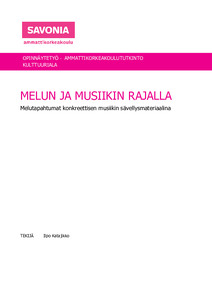Melun ja musiikin rajalla. Melutapahtumat konkreettisen musiikin sävellysmateriaalina.
Katajikko, Ilpo (2023)
Avaa tiedosto
Liite 3 Rajalla teoksen äänite
Lataukset:
Katajikko, Ilpo
2023
Julkaisun pysyvä osoite on
https://urn.fi/URN:NBN:fi:amk-2023052313393
https://urn.fi/URN:NBN:fi:amk-2023052313393
Tiivistelmä
Opinnäytetyö on taiteellinen produktio. Taiteellisessa osuudessa tekijä loi tilataideteoksen, jossa yhdistyi roskamuovipatsas ja melumusiikkiteos. Kirjallisessa osuudessa tekijän tavoitteena oli tutkia, millä tavoin melutapahtumia on mahdollista tarkastella musiikkina ja miten tekijä itse hyödynsi melua sävellysmateriaalina melumusiikkiteoksessaan. Opinnäytetyön idea kehittyi tekijän kiinnostuksesta epämiellyttäväksi koettuihin ääniin eli meluun. Tekijän tavoitteena oli tuoda esille melun mahdollisuuksia ja melumusiikkia myös yleisön kuultavaksi.
Opinnäytetyön kirjallinen osuus jäsentyi kolmeen osaan: Tietoperustalukujen laatimisen yhteydessä tekijä tutustui ensin aiemman kirjallisuuden välityksellä konkreettiseen musiikin historiaan ja melun käyttöön säveltämisessä. Tämän jälkeen tekijä kuvasi taiteellisen produktionsa toteutuksen ja reflektoi sävellysprosessiaan. Musiikillisen osuuden rakennetta tekijä havainnollisti Helmut Lachenmannin uuden musiikin äänityypit -teorian pohjalta.
Opinnäytetyön tuloksena syntyi tilataideteos Rajalla, joka esitettiin Kuopiossa 15.–16.12.2022. Tekijä hyödynsi melua teoksessaan melodiana, säestyksenä sekä siirtymien yhteydessä. Teoksesta löytyi Lachenmannin teorian äänityyppejä. Kirjallisessa työssä sävellysteoksensa analysoinnin ja tietoperustaluvussa hyödyntämiensä lähteiden pohjalta tekijä kehitti uuden käsitteen ”meludia” edistämään melumusiikkiin liittyvää tutkimusta sekä melumusiikista käytävää keskustelua. Tekijä oppi opinnäytetyöprosessissa konkreettisenmusiikin säveltämisen periaatteita ja kehittyi sekä säveltäjänä että yleisesti taiteilijana. Teoksen vastaanotosta päätellen tekijä onnistui tuomaan melumusiikkia ja sen mahdollisuuksia tiedettäväksi yleisölle. This thesis is an artistic production. The purpose of this thesis is to process the use of noise in composing concrete music. In the artistic part, the author created an installation art piece that combined a plastic waste sculpture and a noise music composition. In the written part, the author's goal was to examine how noise events can be viewed as music, and how the author used noise as a compositional material in their noise music composition. The idea for the thesis developed from the author's interest in unpleasant sounds i.e., noise. The author's goal was to showcase the possibilities of noise and noise music to the audience by making it audible.
The written part of the thesis was divided into three sections: During the development of the theoretical framework, the author first familiarized themselves with the history of concrete music and the use of noise in composition through previous literature. After that, the author described the realization of the artistic production and reflected on their composition process. The structure of the music part was illustrated by the theory of Helmut Lachenmann's sound types in new music.
As a result of the thesis, the installation art piece Rajalla was performed in Kuopio on December 15–16.12.2022. The author utilized noise in the composition as a melody, accompaniment, and in transitions. The sound types from Lachenmann's theory were also found in the piece. In the written part of the thesis, based on the analysis of their composition and the sources used in the theoretical part, the author developed a new concept called meludia to promote research and discussion about noise music. Through the process of their thesis, the author learned principles of concrete music composition and developed as both a composer and an artist in general. Based on the reception of the work, the author succeeded in bringing noise music and its possibilities to the attention of the public.
Opinnäytetyön kirjallinen osuus jäsentyi kolmeen osaan: Tietoperustalukujen laatimisen yhteydessä tekijä tutustui ensin aiemman kirjallisuuden välityksellä konkreettiseen musiikin historiaan ja melun käyttöön säveltämisessä. Tämän jälkeen tekijä kuvasi taiteellisen produktionsa toteutuksen ja reflektoi sävellysprosessiaan. Musiikillisen osuuden rakennetta tekijä havainnollisti Helmut Lachenmannin uuden musiikin äänityypit -teorian pohjalta.
Opinnäytetyön tuloksena syntyi tilataideteos Rajalla, joka esitettiin Kuopiossa 15.–16.12.2022. Tekijä hyödynsi melua teoksessaan melodiana, säestyksenä sekä siirtymien yhteydessä. Teoksesta löytyi Lachenmannin teorian äänityyppejä. Kirjallisessa työssä sävellysteoksensa analysoinnin ja tietoperustaluvussa hyödyntämiensä lähteiden pohjalta tekijä kehitti uuden käsitteen ”meludia” edistämään melumusiikkiin liittyvää tutkimusta sekä melumusiikista käytävää keskustelua. Tekijä oppi opinnäytetyöprosessissa konkreettisenmusiikin säveltämisen periaatteita ja kehittyi sekä säveltäjänä että yleisesti taiteilijana. Teoksen vastaanotosta päätellen tekijä onnistui tuomaan melumusiikkia ja sen mahdollisuuksia tiedettäväksi yleisölle.
The written part of the thesis was divided into three sections: During the development of the theoretical framework, the author first familiarized themselves with the history of concrete music and the use of noise in composition through previous literature. After that, the author described the realization of the artistic production and reflected on their composition process. The structure of the music part was illustrated by the theory of Helmut Lachenmann's sound types in new music.
As a result of the thesis, the installation art piece Rajalla was performed in Kuopio on December 15–16.12.2022. The author utilized noise in the composition as a melody, accompaniment, and in transitions. The sound types from Lachenmann's theory were also found in the piece. In the written part of the thesis, based on the analysis of their composition and the sources used in the theoretical part, the author developed a new concept called meludia to promote research and discussion about noise music. Through the process of their thesis, the author learned principles of concrete music composition and developed as both a composer and an artist in general. Based on the reception of the work, the author succeeded in bringing noise music and its possibilities to the attention of the public.
